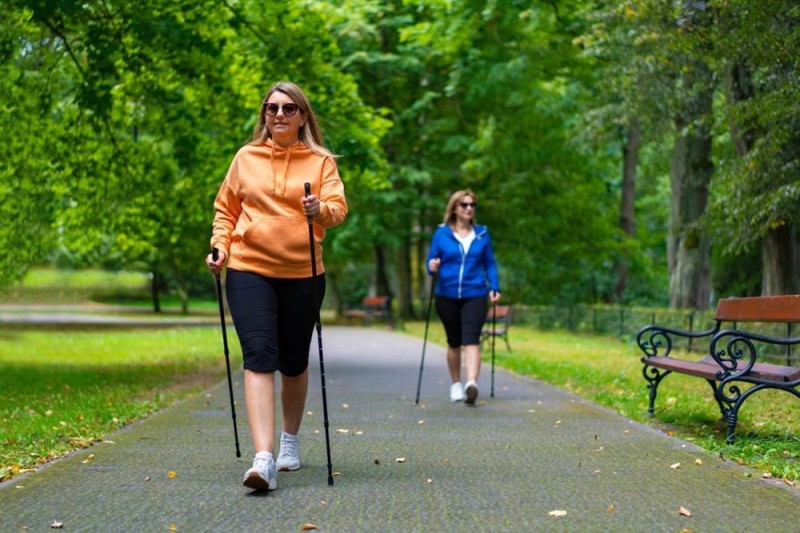
你是个“计步控”吗?你是否每天多次查看手机、手表或其他活动追踪器,检查自己是否已达到一万步的目标?如果你的步数从未超过7,000步,是否会有负罪感?如果日行万步的标准只是20世纪60年代一场吸引公众眼球的营销活动,而最新科学表明7,000步才是真正具有健康效益的门槛呢?事实正是如此。
最新发表在《柳叶刀·公共卫生》(The Lancet Public Health)期刊上的大规模分析研究,对传说中的日行万步目标提出了质疑。该研究汇集了全球57项研究、超过16万名成年人的数据。研究人员得出结论:日行7,000步实际上与显著延长寿命、预防多种疾病密切相关,而且多走3,000步并不会带来明显差异。
日行万步何以被奉为“黄金标准”
多年来,“日行万步”被奉为日常健身的黄金标准。但这一基准的起源并非医学研究,而是市场营销。1964年东京奥运会前夕,一款名为“万步计”的日本计步器在全球掀起了一股健身热潮。这个朗朗上口的整数从此深入人心,成为数百万可穿戴设备用户的默认目标。
日行万步基准似乎只是你深信不疑的众多观念之一。YouTube热门博主和健身网红发起“万步挑战”,鼓励粉丝达到或超越每日目标,常常会安排“跟我一起走”的锻炼直播。数字应用赋予“日行万步”官方地位,这个数字如今已成为Fitbit等设备的默认设置。企业健康计划、社交媒体挑战赛和公共卫生宣传活动也普遍将万步目标用作激励目标和成就徽章。
颠覆性研究发现
这项新研究给“日行万步是科学最低标准”的观点泼了冷水。与最不活跃人群(2,000步)相比,每日完成7,000步的人群呈现出以下变化:
• 过早死亡风险降低47%
• 心血管疾病发病几率降低25%
• 痴呆症风险降低38%
• 癌症风险降低6%
• 抑郁症状发生率降低22%
• 跌倒风险降低28%
• 罹患2型糖尿病风险降低14%
更重要的是,这些巨大的健康效益在7,000步时已接近平台期;每日坚持走满一万步,额外带来的降低大多数疾病风险的效果微乎其微。对于某些疾病(如心脏病)而言,超过7,000步后健康效益略有提升,但对许多其他疾病而言,增长曲线已趋于平缓。
这项研究的摘要指出:“尽管对于那些比较活跃的人群而言,日行万步仍是可行目标,但日行7,000步即与具有临床意义的健康改善相关,对部分人而言可能是更现实且可达成的目标。”作者补充道,需结合其局限性解读研究结果,例如多数健康结果可参考的研究数量有限、缺乏针对特定年龄段的分析,以及单项研究层面可能存在偏差等。
“越多越好”,但要有度
尤其对久坐人群而言,多走路依然有益健康。研究发现,当步数从极低水平(约2,000步)提升至每天7,000步时,健康获益增幅最大。对普通成年人群而言,7,000步(约三英里)即可获得大部分健康效益。60岁以上人群的效益平台期稍早出现,约在6,000至8,000步之间;而较年轻人群的平台期可能更接近8,000至10,000步。
研究人员还揭示,步行速度远不如步数重要:只要完成步数,无论速度快慢,都能获得保护性益处。
重新思考健身理念
这项研究可能促使公共卫生宣传方式进行革新——长期以来,宣传往往推崇鼓舞人心但略显武断的目标。健身专业人士和可穿戴设备制造商如今有了新证据,可以向客户和消费者说明:每日7,000步的目标既切实可行,又能提供强大的健康保护作用。不过话说回来,“万步”这个数字确实朗朗上口。
关于本文,《财富》杂志使用了生成式AI辅助完成初稿。编辑在发布前已核实信息的准确性。 (*)
译者:刘进龙
审校:汪皓
你是个“计步控”吗?你是否每天多次查看手机、手表或其他活动追踪器,检查自己是否已达到一万步的目标?如果你的步数从未超过7,000步,是否会有负罪感?如果日行万步的标准只是20世纪60年代一场吸引公众眼球的营销活动,而最新科学表明7,000步才是真正具有健康效益的门槛呢?事实正是如此。
最新发表在《柳叶刀·公共卫生》(The Lancet Public Health)期刊上的大规模分析研究,对传说中的日行万步目标提出了质疑。该研究汇集了全球57项研究、超过16万名成年人的数据。研究人员得出结论:日行7,000步实际上与显著延长寿命、预防多种疾病密切相关,而且多走3,000步并不会带来明显差异。
日行万步何以被奉为“黄金标准”
多年来,“日行万步”被奉为日常健身的黄金标准。但这一基准的起源并非医学研究,而是市场营销。1964年东京奥运会前夕,一款名为“万步计”的日本计步器在全球掀起了一股健身热潮。这个朗朗上口的整数从此深入人心,成为数百万可穿戴设备用户的默认目标。
日行万步基准似乎只是你深信不疑的众多观念之一。YouTube热门博主和健身网红发起“万步挑战”,鼓励粉丝达到或超越每日目标,常常会安排“跟我一起走”的锻炼直播。数字应用赋予“日行万步”官方地位,这个数字如今已成为Fitbit等设备的默认设置。企业健康计划、社交媒体挑战赛和公共卫生宣传活动也普遍将万步目标用作激励目标和成就徽章。
颠覆性研究发现
这项新研究给“日行万步是科学最低标准”的观点泼了冷水。与最不活跃人群(2,000步)相比,每日完成7,000步的人群呈现出以下变化:
• 过早死亡风险降低47%
• 心血管疾病发病几率降低25%
• 痴呆症风险降低38%
• 癌症风险降低6%
• 抑郁症状发生率降低22%
• 跌倒风险降低28%
• 罹患2型糖尿病风险降低14%
更重要的是,这些巨大的健康效益在7,000步时已接近平台期;每日坚持走满一万步,额外带来的降低大多数疾病风险的效果微乎其微。对于某些疾病(如心脏病)而言,超过7,000步后健康效益略有提升,但对许多其他疾病而言,增长曲线已趋于平缓。
这项研究的摘要指出:“尽管对于那些比较活跃的人群而言,日行万步仍是可行目标,但日行7,000步即与具有临床意义的健康改善相关,对部分人而言可能是更现实且可达成的目标。”作者补充道,需结合其局限性解读研究结果,例如多数健康结果可参考的研究数量有限、缺乏针对特定年龄段的分析,以及单项研究层面可能存在偏差等。
“越多越好”,但要有度
尤其对久坐人群而言,多走路依然有益健康。研究发现,当步数从极低水平(约2,000步)提升至每天7,000步时,健康获益增幅最大。对普通成年人群而言,7,000步(约三英里)即可获得大部分健康效益。60岁以上人群的效益平台期稍早出现,约在6,000至8,000步之间;而较年轻人群的平台期可能更接近8,000至10,000步。
研究人员还揭示,步行速度远不如步数重要:只要完成步数,无论速度快慢,都能获得保护性益处。
重新思考健身理念
这项研究可能促使公共卫生宣传方式进行革新——长期以来,宣传往往推崇鼓舞人心但略显武断的目标。健身专业人士和可穿戴设备制造商如今有了新证据,可以向客户和消费者说明:每日7,000步的目标既切实可行,又能提供强大的健康保护作用。不过话说回来,“万步”这个数字确实朗朗上口。
关于本文,《财富》杂志使用了生成式AI辅助完成初稿。编辑在发布前已核实信息的准确性。 (*)
译者:刘进龙
审校:汪皓
Are you a step-checker? Do you look at your phone, watch, or other activity tracker a few times a day, to see if you’ve hit the 10,000 steps mark yet? Do you feel guilty if your step count doesn’t ever get over, say, 7,000? What if the 10,000-steps-per-day mark was just a publicity campaign from the 1960s that caught the public’s attention, and recent science indicates that 7,000 is the true mark that carries a health benefit with it? That is exactly the scenario that’s playing out.
The latest large-scale analysis, published in The Lancet Public Health and drawing from over 160,000 adults across 57 studies worldwide, challenges the fabled 10,000-step mark. Researchers not only concluded that walking 7,000 steps per day was in fact linked to dramatic improvements in longevity and protection against a wide array of diseases, but that going the extra 3,000 steps didn’t make that much of a difference after all.
Why 10,000 steps became ‘the goal’
For years, “10,000 steps” has been consecrated as the gold standard of daily fitness. But the origin of that benchmark wasn’t medical—it was marketing. Ahead of the 1964 Tokyo Olympics, a Japanese pedometer called the “manpo-kei,” which translates to “10,000-step meter,” launched a global fitness trend. That catchy round number stuck, becoming the default goal for millions using wearable trackers.
The 10,000 steps benchmark just seems to be one of those things that lodges in your head. Popular YouTubers and fitness influencers run “10,000 step challenges” encouraging followers to meet or exceed the daily target, often featuring “walk with me” workout sessions. It’s been granted official status by digital apps, with the number “10,000” now a default setting on devices such as Fitbit. Corporate wellness programs, social media challenges, and public health campaigns also routinely use the 10,000-step mark as a motivational goal and badge of accomplishment.
The bombshell findings
The new research poured cold water on the idea of 10,000 as a scientific minimum. Compared to the least active group (2,000 steps), those who managed 7,000 steps per day saw:
• 47% decreased risk of premature death
• 25% lower chance of cardiovascular disease
• 38% reduced risk of dementia
• 6% lower cancer risk
• 22% lower incidence of depressive symptoms
• 28% reduction in falls
• 14% lower risk of developing Type 2 diabetes
What’s more, these massive benefits approached a plateau with 7,000 steps; walking all the way to 10,000 steps per day generated only small additional reductions in risk for most conditions. For some diseases—like heart disease—benefits increased slightly beyond 7,000, but for many others, the curve flattened.
“Although 10,000 steps per day can still be a viable target for those who are more active,” according to the abstract, “7,000 steps per day is associated with clinically meaningful improvements in health outcomes and might be a more realistic and achievable target for some.” The authors add that the findings should be interpreted in light of limitations, such as the small number of studies available for most outcomes, a lack of age-specific analysis and potential biases at the individual study level.
‘More is better’—but only up to a point
Walking more remains beneficial, particularly for those who are mostly sedentary. The study found the greatest jump in health benefits when moving from very low step counts (~2,000) up to 7,000 daily. For the general adult population, 7,000 steps—about three miles—delivers the bulk of the effect. For adults over 60, benefits plateau a bit earlier, around 6,000–8,000 steps, while younger adults may see the curve level off closer to 8,000–10,000.
The researchers also revealed that the pace of walking was far less important: just getting in the steps, regardless of speed, provided the protective benefits.
Rethinking the fitness message
This research could prompt a shake-up in public health messaging, which has long promoted aspirational but somewhat arbitrary targets. Fitness professionals and wearable device makers now have fresh evidence to advise clients and consumers that a daily goal of 7,000 is both realistic and powerfully protective. Then again, 10,000 steps is catchy.
For this story, Fortune used generative AI to help with an initial draft. An editor verified the accuracy of the information before publishing.

